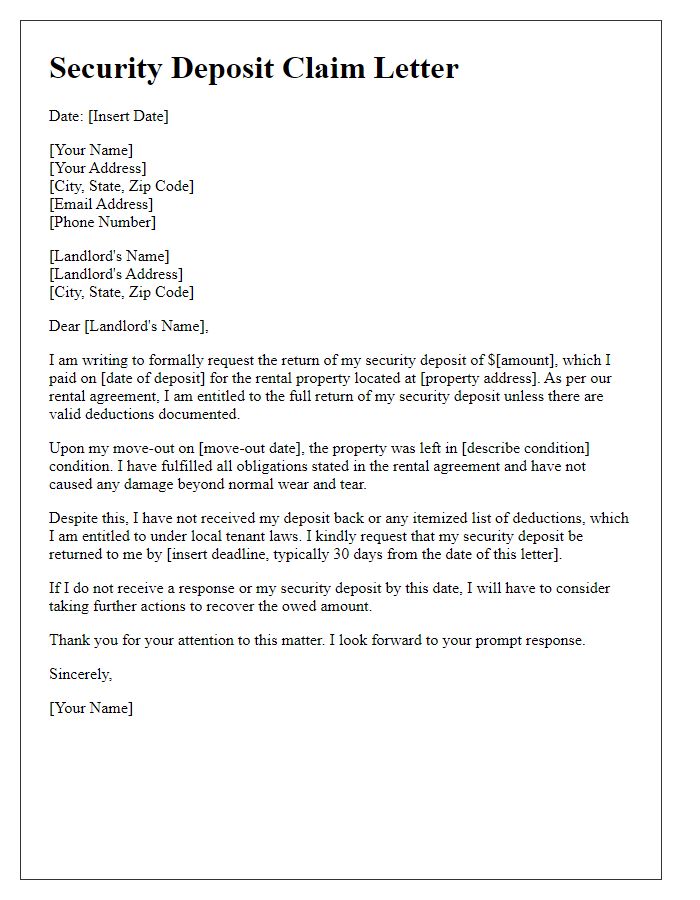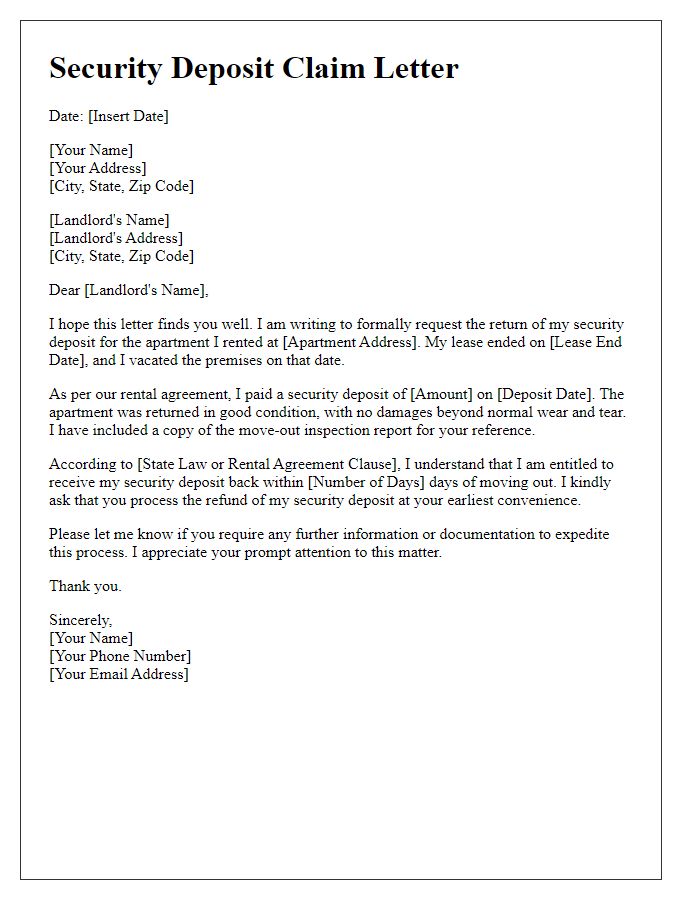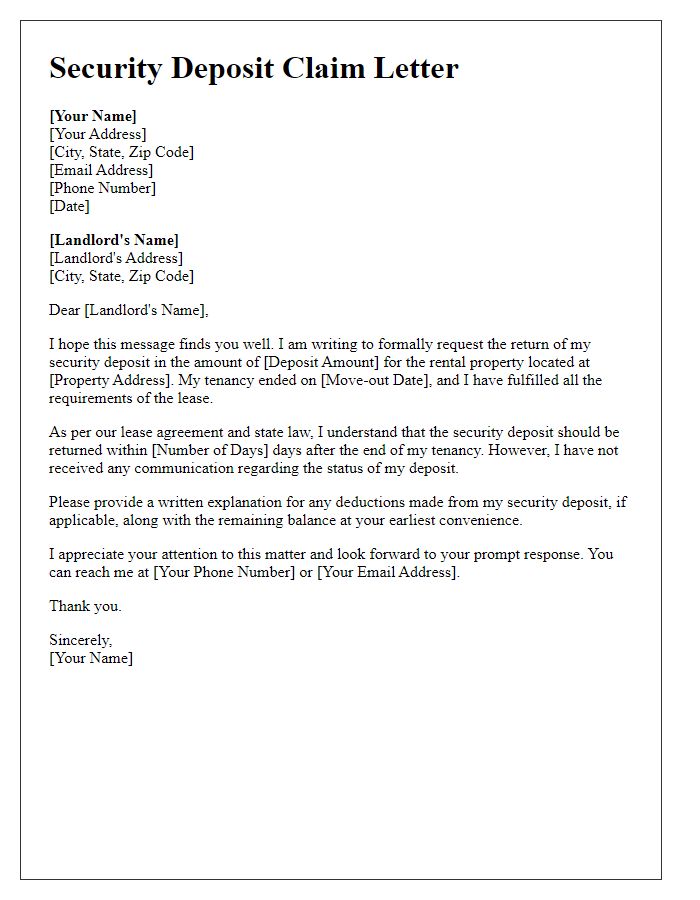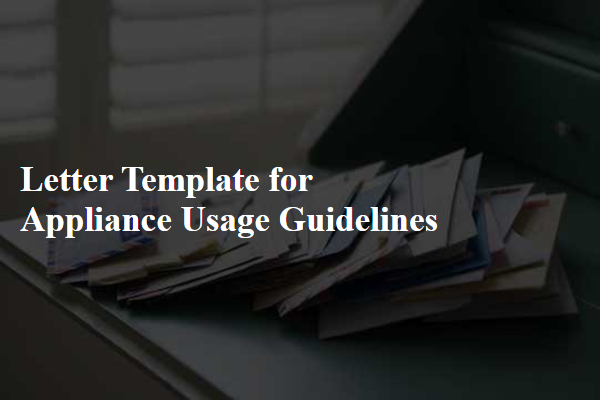Are you looking to reclaim your security deposit but unsure where to start? Crafting a well-structured letter can make all the difference in navigating this process smoothly. In this article, we'll guide you through the essential components of a security deposit claim letter, ensuring you include all necessary details while maintaining a professional tone. So, let's dive in and help you get that deposit back in your pocket!

Tenant and Landlord Information
The security deposit claim process involves various key elements that must be outlined clearly. Tenant information typically includes the full name, address of the residence (including city and state), and contact details such as phone number and email address. Landlord information should consist of the property owner's name, address (which may differ from the rental property), and contact information, including phone number and email. Important dates such as the lease start date and end date should also be noted, as well as the amount of the security deposit initially paid. Additionally, any specific conditions outlined in the lease regarding deductions for damages or cleaning should be highlighted to provide context for the claim. Finally, a brief description of the reasons for the security deposit claim helps clarify the dispute, including specific incidents such as property damage or necessary repairs.
Lease Terms and Property Details
A security deposit claim typically involves details on lease terms and property specifics that are essential for informing property management or landlords. The lease agreement, often outlining critical elements such as rental duration (usually 12 months) and monthly rent amounts (for instance, $1,500 per month), serves as the foundation for claims regarding the return of the deposit. Property details, including the address (e.g., 123 Main St, Anytown, USA), the condition of the property upon move-out, and any deductions being contested, play a crucial role in clarifying the state of the premises during tenancy. Additionally, documenting any repairs made prior to departure, which may have incurred costs, is vital for substantiating claims against the security deposit retention.
Security Deposit Amount and Deductions
When tenants vacate a rental property, understanding the security deposit amount is crucial. The typical security deposit, often equivalent to one month's rent, serves as a financial safeguard for landlords against potential damages or unpaid rent. Upon move-out, landlords must provide a detailed account of deductions, including repairs (e.g., damage to walls or flooring), cleaning services, or unpaid invoices for utilities (such as gas, water, or electricity). These deductions must comply with local regulations, like those found in California's Civil Code Section 1950.5, which mandates specific timelines for returning the remaining deposit balance. Disputes may arise over the justification of deductions, requiring tenants to document the property's condition upon departure. Proper communication regarding the security deposit can help avoid legal conflicts and foster positive landlord-tenant relations.
Legal References and Rights
A security deposit claim involves the return of funds paid by tenants to landlords (homeowners) before occupying a rental property. Legal frameworks vary by state, with typical regulations found in statutes, such as the Uniform Residential Landlord and Tenant Act (URLTA). In most jurisdictions, landlords must return the security deposit within a specific timeframe after lease termination, often ranging from 14 to 60 days, depending on local laws. Deductions for damages must be itemized and justified, ensuring transparency in transactions. Tenants have the right to dispute unreasonable charges, often leading to civil court claims if deposits are withheld unlawfully. Maintaining records, such as inspection reports and communications, is crucial for protecting tenants' rights in these disputes.
Contact Information and Follow-up Instructions
When filing a security deposit claim, clear contact information is essential to facilitate communication between landlords and tenants. Include items like name, address, and phone number to ensure all parties are easily reachable. Follow-up instructions should provide clear steps on how to respond to the claim. Indicate timelines, such as a 30-day response window, and preferred communication channels, whether through email or certified mail. These guidelines enhance the efficiency of the process, ensuring that necessary discussions regarding the security deposit, typically one month's rent, can be resolved amicably and legally.
Letter Template For Security Deposit Claim Samples
Letter template of security deposit claim for non-compliance with rental agreement.
















Comments